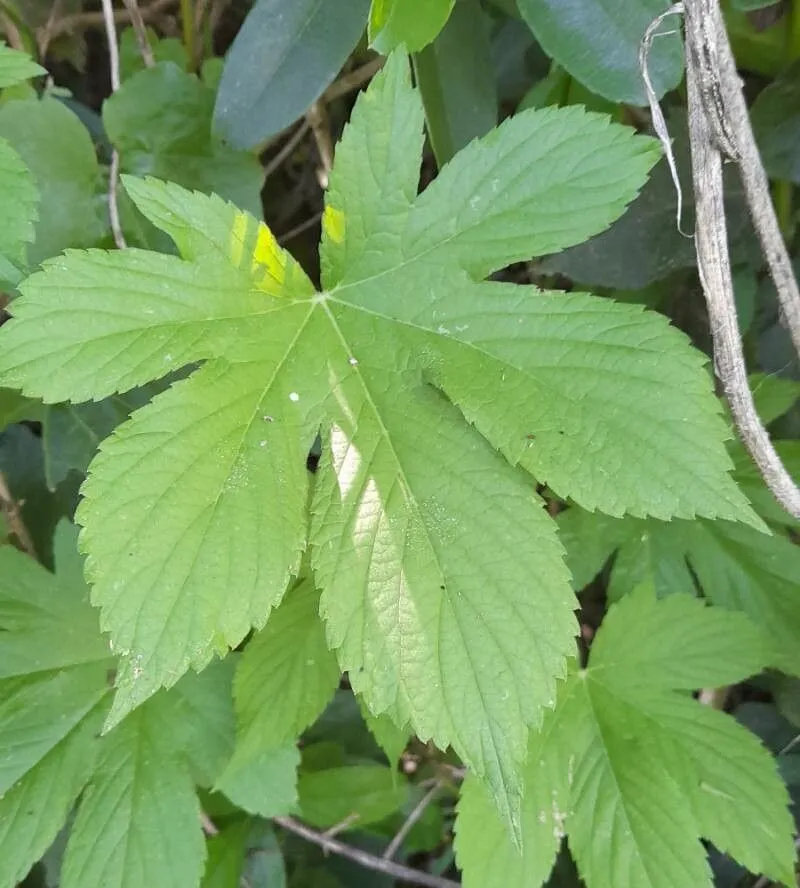
Author: (Lour.) Merr.
Bibliography: Trans. Amer. Philos. Soc., n.s., 24(2): 138 (1935)
Year: 1935
Status: accepted
Rank: species
Genus: Humulus
Vegetable: Unknown
Observations: Russian Far East to N. Vietnam and Temp. E. Asia
Japanese hop, scientifically known as Humulus scandens, is a vigorous and sprawling species belonging to the Cannabaceae family. Native to a wide range extending from the Russian Far East to northern Vietnam and temperate regions of East Asia, this plant has been observed in a variety of climates and habitats within these areas.
Characterized by its robust, twining stems and distinctive palmate leaves, Japanese hop demonstrates a unique capacity to thrive in diverse environmental conditions. Its growth habit is adaptive, capable of scaling and spreading across available surfaces, making it a noteworthy species within its native ecosystem. The foliage typically displays a vibrant green coloration, contributing to the lush appearance of the plant in natural settings.
First noted and elaborated upon in the authoritative work Transactions of the American Philosophical Society, this species was comprehensively described in a 1935 publication, shedding light on its botanical profile and ecological significance. The renowned taxonomist E.D. Merrill, who has made significant contributions to botanical literature, is credited with formally categorizing and describing this species.
As a member of the Cannabaceae family, Humulus scandens shares its lineage with other economically and ecologically important plants, adding to its interest for both researchers and horticulturists. Its presence across a broad geographical swath in East Asia underscores its ecological versatility and evolutionary success in adapting to various environmental challenges.
Despite its aggressive growth, which may pose challenges in some contexts, Japanese hop plays a role in the native flora of its regions, contributing to the biodiversity and complexity of ecosystems. Its study continues to be relevant for understanding plant adaptation, spread, and impact in both native and introduced habitats.
Deu: japan-hopfen, japanischer hopfen
Eng: japanese hop
Ita: luoppolo del giappone
Ces: chmel japonský
Hun: japán komló
Por: lúpulo-do-japão
Nob: japanhumle
Nno: japanhumle
En: Japanese Hop
Bg: Японски хмел
Zh: 葎草
Hr: Japanski hmelj
Cs: Chmel japonský
Fi: Japaninhumala
De: Japanischer Hopfen, Japan-Hopfen
Hu: Japán komló
It: Luppolo del Giappone, Luoppolo del Giappone
Ko: 환삼덩굴
Nb: Japanhumle
Nn: Japanhumle
Pt: Lúpulo-do-japão
Ru: Хмель японский
Es: Japonski hmelj
Sv: Japansk humle
Zh-tw: 葎草
Tt: Япон Колмагы
Taken Nov 5, 2022 by Trap Hers (cc-by-sa)
Taken Nov 5, 2022 by Trap Hers (cc-by-sa)
Taken Sep 10, 2022 by 省三 小谷 (cc-by-sa)
Taken Sep 10, 2022 by 省三 小谷 (cc-by-sa)
© copyright of the Board of Trustees of the Royal Botanic Gardens, Kew.
Family: Myrtaceae Author: (F.Muell.) K.D.Hill & L.A.S.Johnson Bibliography: Telopea 6: 402 (1995) Year: 1995 Status:…
Family: Rubiaceae Author: Pierre ex A.Froehner Bibliography: Notizbl. Bot. Gart. Berlin-Dahlem 1: 237 (1897) Year:…
Family: Sapindaceae Author: Koidz. Bibliography: J. Coll. Sci. Imp. Univ. Tokyo 32(1): 38 (1911) Year:…
Family: Asteraceae Author: A.Gray Bibliography: Pacif. Railr. Rep.: 107 (1857) Year: 1857 Status: accepted Rank:…
Family: Fabaceae Author: Medik. Bibliography: Vorles. Churpfälz. Phys.-Ökon. Ges. 2: 398 (1787) Year: 1787 Status:…
Family: Aspleniaceae Author: (Cav.) Alston Bibliography: Bull. Misc. Inform. Kew 1932: 309 (1932) Year: 1932…